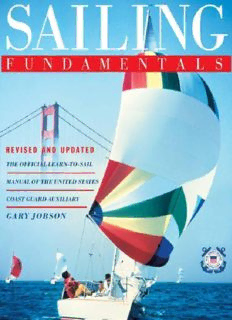
Sailing Fundamentals PDF
Preview Sailing Fundamentals
SAILING FUNDAMENTALS The Official Learn-to-Sail Manual of the United States Coast Guard Auxiliary Revised and Updated ILLUSTRATION BY MARTI BETZ BY GARY JOBSON A TOUCHSTONE BOOK PUBLISHED BY SIMON & SCHUSTER New York London Toronto Sydney New Delhi TOUCHSTONE Rockefeller Center 1230 Avenue of the Americas New York, NY 10020 www.SimonandSchuster.com Copyright © 1984 by American Sailing Association Copyright © 1987,1998 by American Sailing Association and Gary Jobson All rights reserved, including the right of reproduction in whole or in part in any form. TOUCHSTONE and colophon are registered trademarks of Simon & Schuster Inc. Designed by Barbara Marks Manufactured in the United States of America 10 9 8 7 6 Library of Congress Cataloging-in-Publication Data Jobson, Gary Sailing fundamentals. Includes index. 1. Sailing. 2. American Sailing Association. 1. American Sailing Association. II. Title. GV811J62 1986 797.l′24 86-20338 ISBN-13: 978-0-7432-7308-4 ISBN-10: 0-7432-7308-7 eISBN: 978-1-439-13678-2 DUE TO ONGOING CHANGES IN GOVERNMENTAL SAFETY AND NAVIGATION REGULATIONS, THE PRUDENT SAILOR SHOULD KEEP ABREAST OF ANY SUCH CHANGES SINCE THE DATE OF THIS PUBLICATION BY CONTACTING THE NEAREST U.S. COAST GUARD REPRESENTATIVE. CONTENTS United States Coast Guard Auxiliary HOW TO USE THIS BOOK PART ONE INTRODUCTION TO SAILING Overview: The Sailboat and the Wind SAILING KNOWLEDGE All About Boats The Basic Boat Responsibilities of the Skipper and Crew Alcohol and Drug Abuse Federal Requirements for Recreational Boats Review Questions SAILING SKILLS Boarding Sailing Checklist Attaching the Sails Rigging Checklist Using Winches Raising the Mainsail Getting the Boat Moving Getting Out of Irons Coming About or Tacking (Mainsail Only) Jibing (Mainsail Only) Raising the Jib Reaching with Mainsail and Jib Coming About with Mainsail and Jib Sailing a Figure Eight Jibing with Mainsail and Jib Ending the Sail Stowing Sails Docking Summary PART TWO BASIC SAILING SAILING KNOWLEDGE Sail Trim What Makes a Boat Sail Points of Sail Rules of the Road under Sail Review Questions SAILING SKILLS Communications Sailing Close-hauled Sailing on a Run Sailing on a Reach Stopping the Boat Summary PART THREE SAFETY AND SEAMANSHIP SAILING KNOWLEDGE The Safety Harness Deck Safety Hypothermia and Clothing Seasickness Review Questions SAILING SKILLS Sailing a Triangular Course Rescuing a Man Overboard Sailing in Confined Waters Summary PART FOUR BASIC SEAMANSHIP SKILLS SAILING KNOWLEDGE Daysail Planning Chart Symbols Aids to Navigation Anchors and Their Uses The Anchorage Knots Dock Lines and Their Uses Review Questions SAILING SKILLS Anchoring Heaving To Docking under Sail Mooring Summary PART FIVE BASIC COASTAL CRUISING SAILING KNOWLEDGE Terms and Definitions Running Lights Duties of Skipper and Crew for Cruising Rules of the Road under Power Essential Safety Equipment Review Questions SAILING SKILLS Engine Operation-Outboards Troubleshooting the Engine Handling a Vessel under Power Summary PART SIX BASIC COASTAL CRUISING II SAILING KNOWLEDGE Sail Selection Weather Heavy-Weather Sailing Reefing Systems The Magnetic Compass Preparing for Coastal Cruising Running Aground and Other Nuisances Review Questions SAILING SKILLS Reefing Sailing a Compass Course Steering with the Sails Basic Coastal Cruising Checklist Summary PART SEVEN SPECIAL SAILING INFORMATION Special Sailing Information Dinghy Sailing Sailboards Catamarans Launching, Storing, and Maintaining Your Boat A Final Word APPENDIX A Answers to Review Questions APPENDIX B Float Plan APPENDIX C Accident Report Form GLOSSARY INDEX ACKNOWLEDGMENTS UNITED STATES COAST GUARD AUXILIARY Sailing Fundamentals is also the official sailing textbook of the United States Coast Guard Auxiliary (USCGAUX). The USCGAUX is the volunteer civilian component of the United States Coast Guard (USCG). It consists of approximately 35,000 members who wish to further their boating education and who provide administrative, operational, and other support to the USCG. Safe boating education is one of the major missions of the USCGAUX. USCGAUX courses include both classroom and distance-learning (home-study) classes. The USCGAUX does not offer on-the water courses to the general public, although such training is made available to members who wish to engage in search and rescue (SAR), aids to navigation (ATON), and other operational activities that require boat-crew qualification. The USCGAUX public education program includes special courses for children and the Boating Safely Course (BSC), an eight-hour course for powerboaters, operators of personal watercraft (PWC), hunters and fishermen, and others interested in boating safety. The Skipper’s Safe Boating course is a distance-learning course for those whose schedules do not permit classroom attendance. The core program includes the Boating Skills and Seamanship (BS&S) course for powerboaters and the Sailing Fundamentals course for sailors. Boaters with an interest in coastal navigation may take the USCGAUX Basic Coastal Navigation (BCN) and Advanced Coastal Navigation (ACN) courses. Members of the USCGAUX are eligible to take advanced training in a variety of topics, including communications, seamanship, SAR, and navigation, and courses on related topics offered through the USCG Institute. The Skipper’s Safe Boating Course, BSC, BS&S, and Sailing Fundamentals courses are approved by the National Association of State Boating Law Administrators (NASBLA) and graduates may satisfy state requirements for certification in those states that have mandatory education requirements. (Check with your state Boating Law Administrator [BLA] to see if this course is approved in your state.) Additionally, students who graduate from the S&S course also pass the classroom portion of the ASA Basic Keelboat Sailing Standard.
Description: